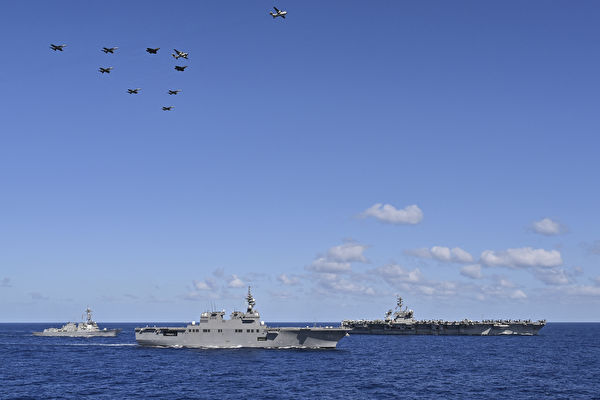Amid escalating tensions in the Taiwan Strait due to the Chinese Communist Party’s (CCP) so-called “encirclement of Taiwan” military exercises, the USS Theodore Roosevelt CVN-71, an aircraft carrier of the US Navy, conducted flight operations in the South China Sea, showcasing its naval strength.
The decision by the CCP authorities to hold military exercises shortly after the inauguration of Taiwan’s newly elected President, Tsai Ing-wen, has drawn international attention.
On Sunday, May 26, the US military’s Defense Visual Information Distribution Service (DVIDS) announced that the Roosevelt aircraft carrier was sailing in the waters of the South China Sea. This Nimitz-class aircraft carrier serves as the flagship of the Ninth Carrier Strike Group and was conducting routine operations in the US Seventh Fleet’s operational area. Publicly available data indicates that the carrier has a displacement of over 100,000 tons.
The US Navy stated that the Seventh Fleet is the Navy’s largest forward-deployed formation, playing a critical role in the Indo-Pacific region by engaging in regular interactions and operations with allies and partners to maintain a free and open environment.
On the same day, the US Navy conducted flight deck exercises on the Roosevelt aircraft carrier, conducting maintenance on MH-60R “Seahawk” helicopters and F/A-18E “Super Hornets” fighter jets.
These actions illustrate the carrier’s combat readiness and its ability to project power and ensure stability in the region.
The CCP concluded a two-day large-scale military exercise last Friday, which purportedly aimed at fully blockading Taiwan. However, this exercise did not cause panic in Taiwan; instead, it revealed vulnerabilities to the US military and showcased Taiwan’s ability to potentially intercept advanced CCP fighter jets.
According to Voice of America, the US Department of Defense stated that the CCP’s military exercise provided a rare opportunity for the US military to gain a deeper understanding of the operations of the CCP’s military forces, showing how challenging it would be for the People’s Liberation Army to successfully carry out the missions they were practicing.
On Saturday, May 25, the US State Department strongly urged the CCP to exercise restraint and cautioned against using routine events as pretext for military provocations, as it may lead to further escalation. Taiwan also condemned these exercises as “overt provocations” on the same day.
On Monday, May 27, a bipartisan delegation led by Michael McCaul, Chairman of the United States House Committee on Foreign Affairs, visited Taiwan and assured President Tsai Ing-wen that the US is fully committed to supporting Taiwan militarily, diplomatically, and economically, guaranteeing expedited weapons deliveries to strengthen deterrence against the CCP.
Earlier this year, the Roosevelt aircraft carrier participated in multiple exercises in the Western Pacific with major allies such as Japan, South Korea, and the Philippines. On May 24, the carrier concluded a port visit to Singapore and resumed its maritime operations thereafter.

